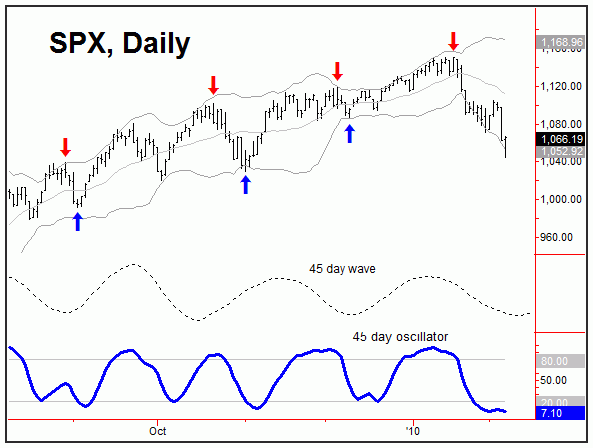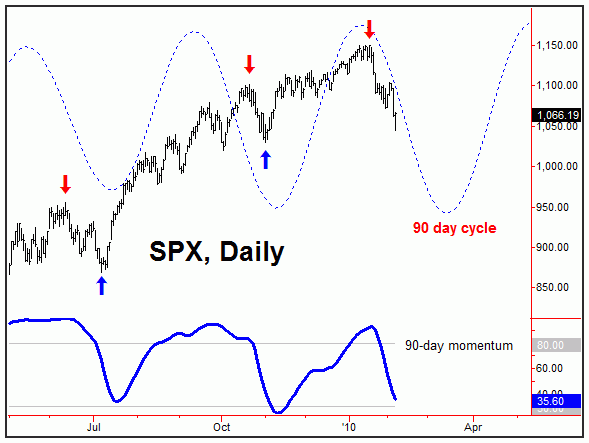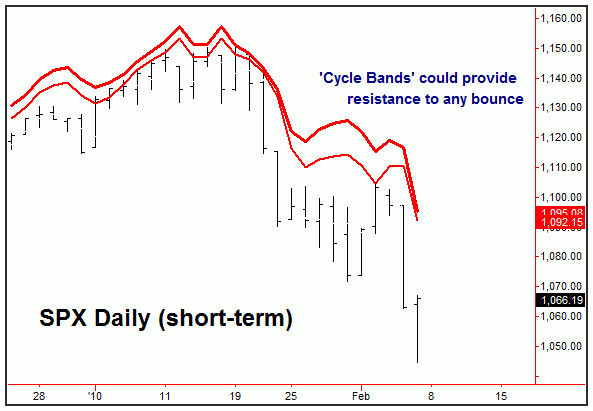Stock Market S&P 500 Down Trend Cycle In Firm Force
Stock-Markets / Cycles Analysis Feb 08, 2010 - 01:26 AM GMTBy: Jim_Curry
 The U.S. stock markets have taken a dive since mid-January, where the various indexes were each in the process of going over larger cyclical peaks. That topping action was then favored to give way to a sharp correction into the month of March - then to be on the lookout for technical signs of the next mid-term low.
The U.S. stock markets have taken a dive since mid-January, where the various indexes were each in the process of going over larger cyclical peaks. That topping action was then favored to give way to a sharp correction into the month of March - then to be on the lookout for technical signs of the next mid-term low.
From a prior article on the Market Oracle, it was pointed out that the most dominant cycle for indexes like the S&P 500 has been the 45-day component - which is the current expression of the nominal 10-week cycle. This particular cycle/wave is nothing new to the markets, and long-time students of cyclical analysis are well aware of it's presence throughout history. Back in the 1990's it was the larger 18-20-week cycle that held the more dominant position, and - even to this day - still holds a firm influence on market direction. Having said that, below is an updated chart of the smaller 45-day cycle:

My prior observations regarding this 45-day cycle had suggested that it would not attempt to bottom out prior to the first week or two of February, simply based upon a detailed statistical analysis of the patterns of this particular component. That is, with it's peak made on 01/19/10 - and it's subsequent breach of the 12/9/09 low (it's last bottom) - this 45-day cycle had to have formed a more bearish pattern - that of a 'higher-high into a lower-low'.
When the above pattern ('higher-high/lower-low') had occurred in the past, the average 45-day down cycle phase lasted an average of 24 trading days off the top, while approximately 85% of those saw their declines lasting at least 14 days or more before bottoming. Thus, this statistical inference favored that any shorter-term rallies that would play out in-between would ultimately fail - and would then be followed by lower lows with this cycle into the first week of February (or beyond).
In terms of time, Friday's break to new lows for the swing has basically satisfied the early-end time expectations for this 45-day component. However, should it's decline see something closer to the statistical average, then it's bottom could potentially push out into 2/22/09 or later. Though this would appear to have lower odds - by no means can it be ruled out - at least until something else were to confirm an earlier-than-expected turn with the same.
In terms of price, the average 45-day down phase within the pattern of a 'higher-high into a lower-low' had been in the range of 8.4%; this favored a move to the 1053 level or lower before the cycle would attempt to bottom. Thus, Friday's action on the S&P has also now satisfied the statistical expectations with price. Even said, that won't mean that the S&P can't continue to push down to even lower numbers, as we do have the 200-day moving average acting as an attractor to price; this key moving average is currently at the 1018 figure, and is rising at about a point per day.
Stepping back just slightly, the larger 90-day (18-20 week) cycle also went over it's top back in January; it is now 65 trading days along from it's last labeled bottom, which was the 11/02/09 low of 1029.38 SPX CASH. Though this rarely occurs with a high degree of precision, should this 90-day cycle bottom where it is currently projected, it will low-out sometime around mid-March of this year. However, I should also point out that this cycle does have a large plus or minus variance of what could be several weeks in either direction. Here is an up-to-date chart of this 90-day cycle:

In taking a look at the pattern analysis of this 90-day cycle, with it's January top it had to have registered the pattern of a 'higher-high'. When seen in the past, the average time decline with this component was in the range of 23 trading days off the top; if seen on the current rotation, the inference is that this 90-day wave won't attempt it's next bottom prior to 02/19/10. On the back-end, approximately 85% of these 90-day down phases have seen their bottoms made on or before the 38 day mark - which makes the suggestion that the low for this cycle could be made on or before 3/12/10. This is important, as the next low for this 90-day component should end up as the next mid-term bottom for the U.S. stock market.
The above-noted observations with the 90-day cycle should be kept in mind going forward, as, in the past, the average rallies off the bottom for this wave have averaged either 14% - or 22% - depending on what pattern ended up being registered at it's bottom. We will have a much better idea on this as we move forward.

Otherwise, for the very short-term cycles, heading into the new trading week the probabilities seem to favora bounce into an early-week high, with resistance at or near the upper red 'Cycle Bands' (chart, above). These bands are currently at the 1092-1095 range on the S&P, but are dropping rapidly and will move to the 1080's (plus or minus) early this week. If tested, they could stall any bounce attempt, thus allowing for a continued push to lower lows (and an eventual test of the 200-day moving average) on the following swing down
By Jim Curry
Market Turns Advisory
email: jcurry@cycle-wave.com
website: http://cyclewave.homestead.com
Jim Curry is the editor and publisher of Market Turns advisory, which specializes in using cyclical analysis to time the markets. To be added to our mailing list click HERE
Disclaimer - The financial markets are risky. Investing is risky. Past performance does not guarantee future performance. The foregoing has been prepared solely
for informational purposes and is not a solicitation, or an offer to buy or sell any security. Opinions are based on historical research and data believed reliable,
but there is no guarantee that future results will be profitable. The methods used to form opinions are highly probable and as you follow them for some time you
can gain confidence in them. The market can and will do the unexpected, use the sell stops provided to assist in risk avoidance. Not responsible for errors or
omissions. Copyright 1998-2010, Jim Curry
JIm Curry Archive
|
© 2005-2022 http://www.MarketOracle.co.uk - The Market Oracle is a FREE Daily Financial Markets Analysis & Forecasting online publication.



